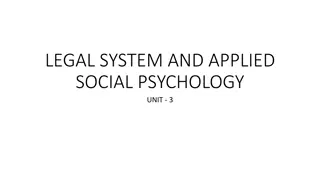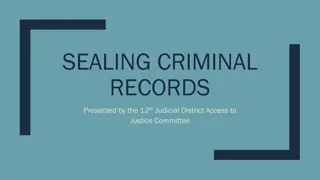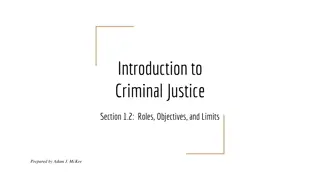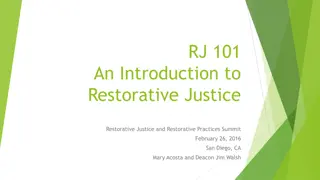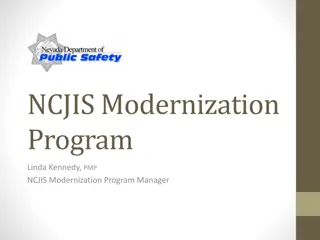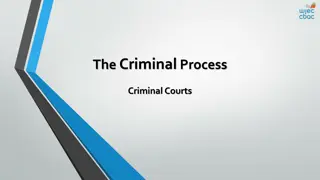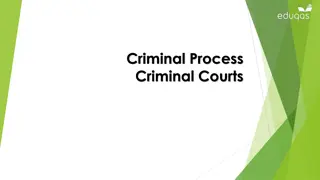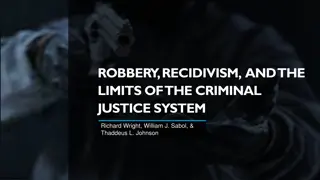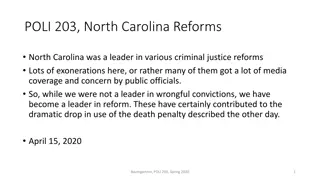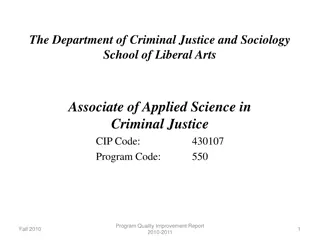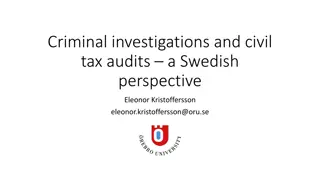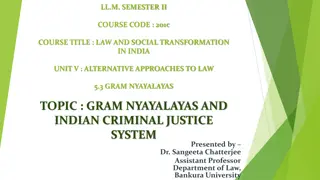Understanding Cross-Version FIRs and Criminal Justice System
This discourse led by Zia ur Rehman, a District & Sessions Judge, Mansehra, sheds light on the evolution, challenges, and solutions related to multiple versions of First Information Reports (FIRs). It also addresses the effectiveness and issues in the criminal justice system in Pakistan, with a statistical analysis of its ranking. Additionally, it provides insights into the significance of precedents in legal systems and the process of criminal investigation.
Download Presentation

Please find below an Image/Link to download the presentation.
The content on the website is provided AS IS for your information and personal use only. It may not be sold, licensed, or shared on other websites without obtaining consent from the author. Download presentation by click this link. If you encounter any issues during the download, it is possible that the publisher has removed the file from their server.
E N D
Presentation Transcript
A DISCOURSE ON CROSS VERSION FIRS By Zia ur Rehman District & Sessions Judge Mansehra 1
2 Objectives of the Session: To apprise the Participants about; Multiple or cross version First Information Reports (FIRs) Evolution of the Law regarding the subject. Analysis of Sughran Bibi case Issues and challenges pertaining to current practice of multiple challans/final reports Workable solutions and way forward
3 OUTCOMES. At the end of the session the participants would be expected to; Have better understanding of the issue Comprehend legal dynamics of cross version cases Play an effective role, in their respective domains, in proper application of the law Develop consensus in promoting uniform practice Improve collaboration with other stake holders of Criminal Justice System
4 Whether Our Criminal justice System is effective enough ? If NO, what could be the reasons?
5 Statistical Analysis of Justice System of Pakistan: Out of 113 countries Pakistan ended up at 105 In regional terms we are the second last, only above Afghanistan In the category of Order and security, at the bottom at 113. Civil Justice - at 107 In criminal Justice ranking - 81 Conviction rate in Pakistan . Conviction rate in India. Conviction rate in Israel. Conviction rate in Japan Conviction rate in U.K. Conviction rate in U.S.A. Conviction rate in Australia A low conviction rate is one of the indicators of poor performance of any criminal justice system. 11.66 % 46 % 93% 99.3 % 84% 85% 85% (Rule of law index, World Justice Project)
6 Brief Comparative Overview of the Legal Systems, focusing on significance of precedents:
Criminal investigation, contd 7 What is Investigation: All proceedings for collection of evidence; consisting of identification, collection, preservation & presentation in a court of law. A multidisciplinary approach. Involves systematic and logical thinking. Requires minute & detailed inspection. Includes observation, examination and fact finding inquiry of a witness.
Stages of Investigation: 8 Investigation generally consists of the following steps:- Proceeding to the spot. Ascertainment of the facts/circumstances of the case. Discovery & arrest of the suspected offender. Collection of evidence. Formation of opinion as to trial of the case. AIR 1955 SC 196.
Significance of Investgation: 9 Provisions of the code dealing with investigation has provided mechanism of check and balance so that fair & impartial investigation is conducted within the framework. If investigation is not conducted in the manner, subsequent proceedings based on such findings would be bound to fall on the ground automatically. 1999 Pcr LJ 1357
Significance of First Information Report. 10 In theory it is only a procedural device for recording and preserving information. In practice, it has assumed overwhelming significance by all the components of the criminal justice system. The police treat it as biblical and thus it controls their investigation. Prosecution is stymied by whatever work has been undertaken by the police. The judiciary on the strength of the precedent is hamstrung to evaluate the evidentiary value of the FIR.
11 whether a Police officer has mandate to determine veracity of information about commission of a cognizable offence? Section 154 CrPc read with Rule.24(4) 0f Police Rules,1934 prescribes that; every information relating to a cognizable offence shall be reduced to writing
12 JUDICIAL PERSPECTIVE 2015 YLR 1096 (Federal Shariat Court) Police cannot determine the veracity of the information Whenever a cognizable offence was reported to the Police, concerned official was bound to register a case under S.154, Cr.P.C. Veracity of contents of the report were correct or not, was not the job of the Police to find. Police had only to collect the material regarding the commission of offence, and then place the same before the competent court of law. Even, if a false report was made by someone, the Police was bound to register a case under S.154, Cr.P.C.Requirement of law was that the information supplied, should be about alleged commission of a cognizable offence, irrespective of the fact, whether such information was ultimately proved to be correct or not.
13 What is a cross version: A version arising out of the same incident but completely or partially different from the one reported earlier through first information report. Two different versions of the same incident resulting into two criminal cases, also known as counter case.
14 Is there any bar on registration of second or third FIR in respect of the same occurrence? If yes then now can the different or new version be recorded and investigated by the police? There is no provision in the code nor in police Rules 1934 for SIR (Second Information Report) or TIR (Third Information report).
Sughran Bibi Case PLD 2018 SC 595 Facts of the case. Mohsin Ali son of Sughran Bibi lost his life in a police encounter on 21.03.2008. FIR No. 177 lodged by Zulfiqar SI on the same day at police station Shah dara town Lahore u/s 324/353/186/34 PPC and section 13 of Arms Ordinance 1965 by alleging that Mohsin Ali and others launched a murderous assault upon a police party and in exercise of right of private defense the police had fired back resulting in death of Mohsin Ali. Upon completion of Investigation a challan was submitted before the court of session Lahore for trial of the nominated accused persons. On 12.01.2010 Sughran Bibi filed a private complaint in respect of the same incident by alleging that her son had cold bloodedly been murdered by the police by staging a fake encounter. On 19.05.2010, a learned Additional Sessions Judge Lahore summoned 16 nominated accused. 15
16 Facts of the case. (Continued) The complaint case was taken up first for trial. On 18.06.2015 formal charge was framed against the summoned accused. A Human rights petition in terms of Article 184 (3) of the Constitution of Islamic Republic of Pakistan was filed before the Supreme Court for issuance of a direction to the police to register a separate FIR. A Larger bench was constituted to determine validity and legality of the registration of separate FIR regarding the same occurrence.
17 Petitioner s (Sughran Bibi) Stance Since in some ensuing administrative and judicial inquiries the local police were found to be guilty of a calculated murder but no separate FIR was registered in that regard so she had to file private complaint, wherein the accused persons were summoned and charge sheeted but no progress had been made so far. She urged that justice would be served if a separate FIR is registered as per her version and accused are ordered to be arrested.
Arguments Advanced 18 Attorney General of Pakistan (adopted by all the Advocate Generals of Provinces) The statutory scheme of the criminal law in vogue in the country envisages registration of only one FIR regarding an incident involving commission of a cognizable offence and every fresh version of the same incident brought to the notice of the Investigating Officer is to be recorded under section 161 Cr.P.C. The I.O is legally obliged to investigate the case from every possible angle and to probe into every version of the incident brought to his notice and then he is to submit his Final Report is the matter in terms of the facts found by him and not in terms of any particular version of the incident advance by any person.
Arguments Advanced) Continued 19 BARRISTER SALAMAN SAFDAR, ASC AMICUS CURIAE Ordinarily there is to be only one FIR but there is no statutory bar against registration of multiple FIRs in respect of the same occurrence if different versions of the incident are advanced with different sets of accused persons and such version disclose commission of different cognizable offence. The remedy of private complaint is generally not considered to be an adequate alternate remedy so that is why people insist upon registration of separate FIR qua their own versions (Arrest Factor)
20 Reasoning aspect of the Judgment Analysis of the pro and contra case law on the subject. Interpretation of the relevant statutory law (Code and police Rules) Deliberation on the nexus between the registration of an FIR and the power of an arrest entrusted to the police under the law.
Reasoning aspect of the Judgment (Continued) 21 Analysis of the case law First Category Allowed only one FIR for an occurrence and clearly provided that all the subsequent statements to the police were to be recorded under section 161 of the Code and that the police officials were free to investigate the case. Consequently, only one trial to take place. Second Category The police were bound to register FIR under section 154 Cr.P.C, hence multiple FIRs could be registered. The outcome of this approach was that it allowed the multiplication of Criminal Proceedings. Hence multiple FIRs meant multiple cases and multiple cases meant multiple trials. Third Category Left the matter to the circumstances of the case. A separate FIR can only be registered if the new version pertains to a different occurrence or discloses commission of a different cognizable offence. Three categories of the judgments
Reasoning aspect of the Judgment (Continued) 22 Interpretation of the law Section 154 thereafter in the ensuing investigation u/s 156, 157 and 159 is a step taken in that case. The gathered information may or may not be in accord with the facts narrated in the FIR. After registration of an FIR the matter becomes a case. Every step taken Section 160 (Power to require attendance of those acquainted with the circumstances of the case) irrespective of the version of the incident narrated by the first information through the FIR. Every new information (version) received is not to require registration of a separate FIR because such information is a part of investigation of the same case which has already been registered. The IO to embark upon an exercise to discover the actuality of the matter
Reasoning aspect of the Judgment (Continued) 23 Difference between case and information Rule 24.1 police Rules, 1934 Information to the police relating to an offence, received under section 154 Cr.P.C Rule 24.5 Police Rules, 1934 Information received and registered is treated as a Case bearing an annual number, which remains the same forever irrespective of any number of different versions received regarding commission of the said offence or any number of different circumstances or set of culprits. Analogy from registration of motor vehicles.
Reasoning aspect of the Judgment (Continued) 24 Rule 24.17 Police Rules, 1934 (Successive Special Reports) The case and its number in the police record remains the same whatever development may take place during the investigation of the case and that is also true of any new version advanced or any new set of culprits introduced during the progress of the investigation. Rule 25.3 Police Rules, 1934 Duty of an I.O to find out the truth. His object shall be to discover the actual facts of the case and to arrest the real offender. He shall not commit himself prematurely to any view of the facts or against any person. This Rule should suffice to dispel any impression that investigation is to be restricted to the version of FIR. The Final report to be submitted under section 173 Cr.P.C is to be based upon his final opinion, which is not to be guided by what first informant had stated or alleged.
Reasoning aspect of the Judgment (Continued) 25 Clarification of a misunderstanding FIR is not the version of the incident reported to the police It is only an information about commission of a cognizable offence and not about the circumstances in which such offence was committed or by whom committed If the mode or manner of commission or the accused is named then that is just a version of the informant. I.O is free to entertain any member of such version.
Reasoning aspect of the Judgment (Continued) 26 Nexus between FIR and Power of arrest No linkage between the two Illustration by asking a query from the petitioner Sughran Bibi) The law does not permit arrest of a person merely on the basis of a bald allegation leveled against him. Power under section 54 and 55 Cr.P.C would required credible information, reasonableness, which is not a vague surmise but a bonafide belief on the part of a police officer. One of the reasons of insistence on registration of FIR, and not to avail alternate remedy of complaint, is an increasing willingness, nay eagerness on the part of I.O to affect arrest of the accused even before initiating or launching a proper investigation of the allegation leveled in FIR. Lodging of an information does not make a person an accused. He becomes an accused when charged in a trial.
Reasoning aspect of the Judgment (Continued) 27 Nexus between FIR and Power of arrest Rule 25.2 (2) Police Rules, 1934 No avoidable trouble shall be given to any person from whom enquiries are made and no person shall be unnecessarily detained. Mandate of Art 4(1) (j) Police Order, 2002 read with Police Rules 24.1, 24.4, 24.7, 25.2 (1), 25.2 (3), 26.1, 26.2 and 26.9 demands existence of sufficient ground for arrest. The power to arrest is permissive and not obligatory.
Reasoning aspect of the Judgment (Continued) 28 Ratio of the Judgment Only one FIR of an occurrence Any number of versions to be recorded u/s 161 Cr.P.C and no separate FIR of new version. I.O to find out the truth of the matter by investigating it from all possible angles and to arrest the real offender. Ordinarily no person is to be arrested straightaway only because he has been nominated in the FIR or in any other version. Arrest after sufficient justification Upon conclusion of the Investigation the report to be submitted (not reports) under section 173 Cr.P.C is to be based upon the actual facts discovered during investigation irrespective of the version of the incident advance by the first informant or any other version brought to the notice of the IO by any other person.
Reasoning aspect of the Judgment (Continued) 29 Whether the practice, in vogue, of multiple final reports/challans is in consonance with the spirit of the judgment?
Reasoning aspect of the Judgment (Continued) 30 Certainly, it is not. Why? There is no concept of more than one final reports in a case. I.O does not bother to dig out the real facts and submits reports against both the parties, which is violation of the concept of fair and impartial investigation. Law of Evidence does not permit appraisal of evidence of the other case. How could two trials of one case be conducted ordinarily? It is the case and not the final report/challan which is to be cancelled under Rule 24.7 of the Police Rules. In case of cancellation of a challan what would be fate of the other challan? Therefore, the practice is alien to the law and the judgment already circulated to the police department for compliance.
31 Way forward ? Only one FIR, one final report/challan and one trial. Where both the parties are found guilty one Final Report may serve the purpose by arraying them as accused with reference to specification of offences and evidence. Remedy for the aggrieved party, whose version is not believed, is to file private complaint. As a matter of legal norm complaint case may be taken up first for trail. (P L D 1966 Supreme Court 708 (Noor Elahi case)
32 Q & A
33 THANKS




